Ijraset Journal For Research in Applied Science and Engineering Technology
- Home / Ijraset
- On This Page
- Abstract
- Introduction
- Conclusion
- References
- Copyright
A New Approach for Sustainable Bioconstruction in Coffee-Growing Environments, based on a Geothermal Bioclimatic System (Simulation)
Authors: Brigith Carolina Belalcazar Acosta, Fabio Alfonso Andrade Suarez, Richard Marcelo Imbachi Chavez , Sergio David Collazos Jojoa, Viviana Andrea Rosero Mera
DOI Link: https://doi.org/10.22214/ijraset.2023.54610
Certificate: View Certificate
Abstract
Colombian coffee is a product recognized worldwide for its mildness, flavor and high-quality. Coffee growing in Colombia is an important sector that contributes to the country\'s economy. The department of Cauca, due to its geolocation, biodiversity and climatic conditions, has become the fourth largest coffee producer in the country, outstanding for the production of specialty coffees, and supporting rural economies. The objective of this research is to analyze the viability and functioning of the model of a Canadian well in a coffee environment, applying concepts of vernacular and biophilic architecture in a coffee growing house located in the municipality of Cajibío, Cauca. Initially, a bibliographic analysis was carried out to learn about the functioning of Canadian wells and their applications, in addition to a socioeconomic study, constructive analysis and proposal for housing improvement in the context of the plateau of Cajibío, Cauca. The place chosen for the study was the \"Parque Tecnológico de Innovación del Café\" (TECNICAFE), where the required physical and environmental data were recorded (construction of a device to measure variables), in order to carry out a simulation of the bioclimatic design through the Energy 2D software. The behavior of temperature during the day and night was analyzed using two materials in the proposed bioclimatic model: Hemp fiber and PEAD (High Density Polyethylene). Finally, hemp fiber was determined as a construction material for the thermal insulation process in approximately 1 hour of simulation, with a temperature variation of approximately 10 °C above and below the outside temperature, ensuring a level of thermal comfort for people using the house in the study area (living room). This proposal is an alternative to improve the thermal comfort and quality of life of coffee growers.
Introduction
I. INTRODUCTION
Colombia is recognized worldwide for its coffee production. This product is an important link in the country's economy. The Andean zone is the region with the highest concentration of coffee crops due to its agro-climatic conditions [1]. The department of Cauca is located in the Andean zone. Therefore, it is one of the places with the highest number of crops of this emblematic product. This department is divided into four coffee growing regions: Central, North, South and East [2]. In the central coffee region is the municipality of Cajibío, which stands out for the production of high-quality coffee, and is one of the largest producers of coffee in the department, by 2020 it produced 660000 “arrobas” of coffee (equivalent to 16500000 pounds) in 6873 cultivated hectares [2].
In 2018, more than 50% of Colombian coffee farmers, were registered in the statistics of multidimensional poverty [7]. Also, it is established that mainly their living costs are represented in housing, food and health [7]. This perspective of the sector leads to low sustainable development. One of the aspects to consider is the welfare of the coffee growing families in the region, most of them do not have decent housing, negatively impacting their quality of life in terms of habitability [7]. With respect to the above, and to data obtained in social immersion processes (in Cajibío) [8] by the research seedbed SIE2 [9] of the Fundación Universitaria de Popayán (FUP) [9], a project was proposed for the bioclimatic design of a building called "Biohogar" [9] in the area of the Parque Tecnológico de Innovación del Café (Tecnicafé) [10]. For this, the model of a Canadian well design [14] was applied, considering a vernacular architecture [10], this development valued the model of biophilic architecture [15], seeking to improve the quality of life of coffee growers in this region. The bioclimatic design model was based on the analysis of heat transfer [6], identifying the relevant physical variables that determine thermal comfort by the materiality [6] in a housing for coffee growers. As a result of the above, the following research question was generated: How can the Canadian well technique contribute to the habitability of a bio-construction of the " biohogar" model designed for coffee growers in the region? The research hypothesis was defined as follows: the bioclimatic design of a coffee plantation house based on the use of geothermal energy contributes to the improvement of its habitability
The objective of this research is to design a bioclimatic model in the structuring of a house, based on bio-construction materials of the region in coffee-growing environments. For this purpose, the following was carried out: i) characterization of the typologies of coffee-growing houses (considering bioclimatic designs) in the plateau of Cajibío, Cauca. ii) design and experimental bioclimatic model of the selected house. iii) validation tests through the Energy 2D software of the bioclimatic model.
II. METHODOLOGY
A three-phase methodology is proposed for this research. In the first phase, the information related to a Provençal well was documented, the study area was identified, the coffee growers' houses were characterized (information collected in the field by the SIE2 research seedbed of the FUP). In the second phase, climatological data of the site was recorded based on thermodynamic variables (temperature, atmospheric pressure, wind, humidity, etc.), and the design of a prototype Canadian well was proposed, choosing the most suitable materials and characteristics for its optimal operation. Finally, in phase 3, the Energy 3D program was used to simulate the operation of the well.
A. Phase I:
The bioclimatization proposal was developed in the municipality of Cajibío, Cauca [3], this place is located to the northeast of the Cauca capital, its average altitude is 1765 m.a.s.l. with a temperature that varies in a range of 12 to 24 °C. Cajibío has 13 townships (“corregimientos”), including the municipal seat or central zone, and 126 hamlets (“veredas”) [3] (Figure 1). There is great cultural diversity in its population; 3.7% of the population identifies itself as indigenous (Nasa and Misak ethnic groups), 15.8% are Afro-descendants, and 80.5% is considered a peasant community. A large part of the population is dedicated to the cultivation of coffee and other agricultural products; most families have built their houses with materials that are feasible to acquire, considering their context (geographic area), culture and economic stability (DANE) [5].

This research was developed in the village of La Venta, Cajibío [3]. In this place is located the Parque Tecnológico de Innovación del Café (TECNICAFE), an organization dedicated to strengthen R+D+I process to give added value to coffee growing, supporting coffee growing communities, promoting technification, improving the quality of the product for export, from a sustainable perspective. In addition, this place was decisive for the characterization of the housing for coffee growers (activity developed by the architecture program, who did field work, identifying the conditions and needs related to infrastructure, and co-creating a housing proposal). Based on what was observed during the field visits (Figure 2), the deterioration of the coffee growers' houses became evident. The situation of these buildings is due to their age and the economic situation of the families, as some coffee growers do not have the necessary funds to improve their living conditions. In terms of habitability, these houses do not meet the conditions of comfort and warmth expected in a building, and the construction methods used have not been the most optimal.
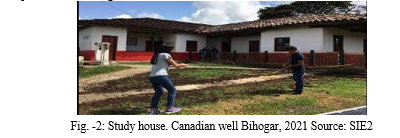
Buildings have deteriorated, leading to the use of "inadequate housing materials in the home in any of the three components such as floor, roof or walls" [4]. This has generated a level of thermal nonconformity in the interior of the houses, produced by poor thermodynamic design. These inappropriate designs are generally a consequence of the low economic resources for their construction, causing negative effects for the welfare of coffee-growing families, such as: health problems, housing habitability problems, poor comfort, economic expenses.
The prototype of the Provençal well was built with recyclable materials, based on the architectural model proposed by SIE2. Initially, for data collection, the materials of the study house were identified. The house has walls made of bahareque, clay tiles, wooden beams and columns, and tile floors. In addition, structural deterioration was evident, caused by its age, climatic conditions, and lack of maintenance.
B. Phase II
Subsequently, variables of temperature, daily probability of precipitation, humidity levels, average wind speed, wind direction, and average daily incident shortwave solar energy (data taken from the meteorological website "Weather Spark") were analyzed. These variables are determinant for the design of the Provençal well. In the Cajibío area, the temperature variation was determined in August 2021, with average maximum temperatures of 24 °C and minimum temperatures of 14 °C; in the other months of the year the average temperature range was from 14 °C to 23 °C. The wettest season is 7 months (from October to May), the month with the highest rainfall is November. In addition, the humidity level during the rainy season is 36%, and during the dry season is 14%. The thermal energy present in the area in summer has an increase of 0.7 kWh, from 4.6 kWh to 5.3 kWh (5.3 kWh being the highest value reported in August) [17].
At TECNICAFE, the missing data were collected, which allowed us to continue with the design proposed in the research. For data collection, a coffee house was considered, which has a deep water well (aljibe) (Figure 3), facilitating the collection of field data and information on humidity and temperature. The aim was to identify the depth at which a good percentage of heat is transferred into the soil, making use of the walls of the well (aljibe). Three temperature sensors were installed at different depths (2m, 4m and 6m) [16].
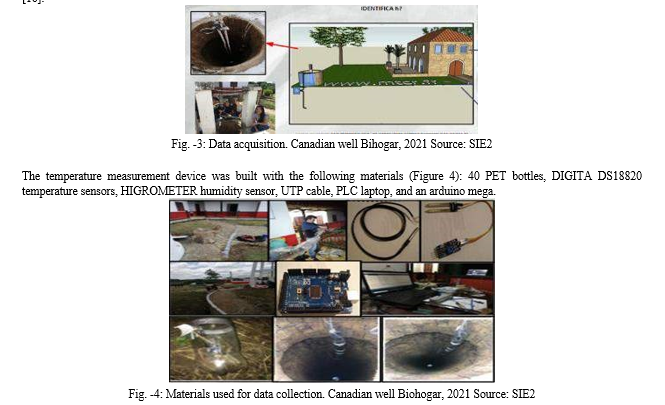
The sensors recorded information through an Arduino board, configured to obtain data every 5 minutes, in order to identify any variation that will occur in temperature and humidity at different depths of the ground. To reduce the data recording noise from the sensors, the environment was controlled with a PET bottle duct covering the instrumentation. This material was chosen because it is lightweight, malleable and recyclable. The union of the bottles formed a duct with a length of 6 meters, facilitating the connection and distribution of the sensors, located every 2 meters. A prototype was made for the measuring instrument (Figure 5) to project the location of the equipment on the walls of the well.

Data recording was done from 3 am to 12 pm (March 3, 2020) (Table 1). Data were recorded for the internal and external temperature of the house, wind speed, and humidity of the environment. Temperature sensor Nº1 installed at 2 m depth recorded from 3:10 a.m. to 9:10 a.m. a stable temperature of 21.5 °C with a minimum variability of 0.5 °C, from 10:10 a.m. to 12:10 p.m. a temperature of 21 °C was recorded. Temperature sensor N° 2, located at 4 m depth, had a constant temperature range during the sampling time from 3:10 a.m. to 12:10 a.m., with lower values than sensor N° 1. Temperature sensor N° 3 located at 6 m depth obtained values between 21 °C and 25 °C and 21 °C, 19 °C throughout the study time. On the other hand, the relative humidity sensor located at 6 m depth recorded a constant humidity, with slight variations (the units provided by the sensor have a range between 0 and 1023 units, where 0 is very humid and 1023 is low humidity). The data indicate that the humidity in the duct is low.

The environment temperature is constant for the first 3 hours, with a value of 13 °C, then from 6:10 a.m. to 11:10 a.m. the temperature increases every hour by 2 °C, and between 11:10 a.m. and 12:10 p.m. the temperature is constant. When determining the temperature deltas (Table 1) between the temperatures measured by the sensors and the environmment temperature, the following data were identified: the delta of sensor N° 1 presents a variation of 8.5 °C in the first three hours, it was reduced until it reached the maximum temperature at noon of 24 °C. This information made it possible to determine the depth necessary to carry out the optimal design of the Canadian well. With the data obtained, a simulation of the geothermal system design was carried out.

III. RESULTS AND DISCCUSSION
A. Experimental Analysis
In order to understand the behavior of the house in different environmental conditions [20] through the ENERGY 2D software (Figure 8), the thermal performance of two specific materials were compared: hemp fiber ("cañamo") [21] and high-density polyethylene, both with thermal insulation properties, commonly used in bioclimatic building construction [22]. The simulation allowed to visualize the thermal behavior of the living room, and to compare the indoor temperature variables with the outdoor temperature. The model of the house was designed in Energy 2D, defining its geometry and characteristics of its construction materials, such as the type of thermal insulation used, thermal conductivity of the walls and roofs. The geothermal system was configured in the simulation, defining the heat transfer from the ground and its distribution in the living room, to achieve heating during the night and cooling during the day. The type of soil in which the house was located was taken into account, which was classified as wet silty clayey clay [23], with a soil thermal conductivity of 1 W/(m*°C), soil specific heat 1,200 J/(Kg*°C), soil density 1,500 Kg/m³ and soil power density 3.33 x 10^-10 W/ m³ [24].

With the results of the simulation, the hemp fiber (“cañamo” demonstrated good thermal performance, a temperature difference of 10°C below the environmment temperature during the day was recorded, indicating a high capacity of the system to make the cooling process of the house. The inclusion of materials such as hemp fiber reduces the environmental impact, contributing to sustainable construction.
This thermal performance of the geothermal bioclimatized system can result in lower energy consumption for heating or cooling the home, generating a reduction in energy costs with a lower carbon footprint. Secondly, the thermal behavior during the night was analyzed (Figure 9), at an environment temperature of 12°C, similar to that of the Cajibío region. It was possible to observe an increase in the temperature inside the house, due to the flow of air that enters and generates a geothermal heat exchange by convection. This phenomenon occurs in the duct that connects the outside of the house with the point of study, resulting in a heating process with a temperature higher than 7°C above the environment temperature (Figure 11). The simulation in Figure 10 shows the initial conditions at night, with an initial temperature of 12°C for all the study zones.

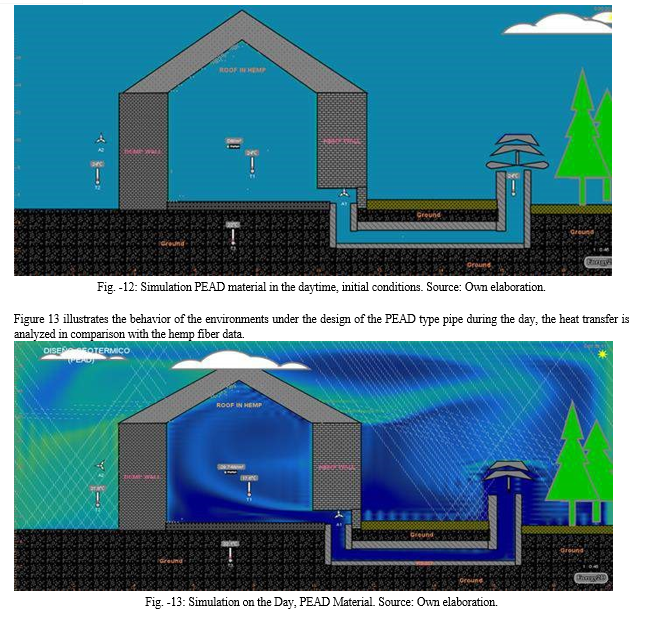
The simulation allowed evaluating the thermal behavior in the "living room", using a geothermal bioclimatized system that incorporated sustainable materials such as hemp fiber and high-density polyethylene (PEAD) in the design. The aim was to determine the capacity of the system to reduce the temperature inside the house, thus reducing the energy consumption required for cooling. First, the performance of the PEAD in the system was evaluated, it was observed that this material demonstrated a good thermal performance, contributing to the reduction of the temperature in the living room. A temperature difference of 10 °C in relation to the environment temperature was recorded, indicating a high capacity of the system in the thermal cooling process of the housing. Secondly, the thermal behavior at night was analyzed (Figure 14 and Figure 15), at an environment temperature of 12 °C. The air flow that entered the interior of the house produced an increase in temperature in the study site, due to the geothermal heat exchange, generating a heating process with a temperature 8°C above the environment temperature.

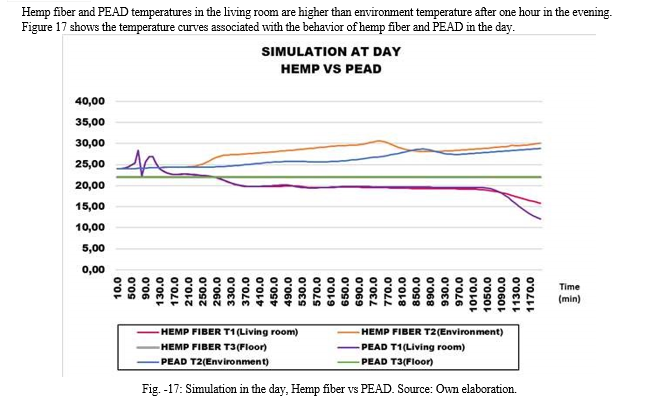
The temperatures of the hemp fiber inside the living room are lower than the temperatures obtained on the covers, resulting in a bioclimatic cooling system.
B. Results Discussion
The following are some relevant considerations concerning the results obtained:
- After identifying the characteristics of the coffee growing houses, the climatic variables were determined through the meteorological website "Weather Spark" to design a Provençal well. The climatic data were complemented with data collection at the study site, through the installation of temperature and soil humidity sensors. The materials used for data collection were recycled and practical. The sensors recorded data every 5 minutes, from 3 am (day 1) to 10 am the following day, in the month of March 2020. The results indicated a stable temperature and constant humidity with a little variation.
- In the design of the bioclimatized system, several important parameters have been considered to ensure its functionality and efficiency. It has been demonstrated that by implementing the horizontal duct at a minimum depth of 2 m, the system meets the appropriate operating conditions as a convective heat exchanger. The air collector should be located at a height of 1.5 m at ground level with an average velocity of 0.3-0.5 m/s.
- In relation to the materials analyzed, hemp fiber and PEAD: Hemp fiber is the most appropriate material due to its sustainable and thermal characteristics, this type of material provides thermal comfort during the day (cooling) and night (heating), ensuring a comfortable and pleasant environment for users. In addition, it has been demonstrated that hemp fiber is a renewable and environmentally friendly material, being considered as a more sustainable option compared to other building materials.
- The adequate functioning of the bioclimatized system depends on the location where it is installed, the characteristics of the floors, the environment, and it is required that the area to be bioclimatized is completely closed in terms of windows and doors, guaranteeing a warm air inside the room, providing a more stable and comfortable environment. In summary, the design of the bioclimatized system has focused on ensuring functionality, efficiency and thermal comfort, and the use of sustainable and renewable materials to reduce its impact on the environment.
IV. ACKNOWLEDGMENT
The authors of this article are especially grateful to the Fundación Universitaria de Popayán for supporting us in this research process, and for facilitating spaces for experimentation and reflection. We would also like to acknowledge and thank TECNICAFÉ, Biohogar R&D, and Cannatural, entities that provided scientific support to this project. Finally, we extend our gratitude to the research seedbed SIE2 de la FUP.
Conclusion
With the characterization of the typology of coffee growing houses towards a bioclimatic design in the plateau of Cajibío, Cauca, traditional construction materials such as adobe, bahareque and clay tiles have been identified in the vernacular architecture. The inadequate use of these materials in combination with materials based on metal sheets generates limitations in thermal efficiency, and negatively influences thermal comfort and energy consumption for heating. With respect to the bioclimatic and geographic conditions of the Cajibío plateau, there is a need to implement measures to improve the materiality of the constructions, with the incorporation of insulation and efficient ventilation systems that optimize the design, allowing coffee growers to achieve greater energy efficiency related to thermal comfort. The socioeconomic characterization of the Cajibío plateau, carried out by members of the FUP Architecture program, indicated that coffee growers had insufficient remuneration derived from traditional coffee production, forcing them to alternate coffee with other types of crops, representing an increase in multidimensional poverty, reducing their quality of life. It was demonstrated that it is feasible to use recyclable materials in the construction of the ducts of the bioclimatic geothermal systems of the \"Canadian well\" type, to improve the living conditions of coffee growers in terms of thermal comfort. The design of the experimental model for the collection of physical data in the Cajibío house allowed establishing the characteristics of the model for the efficient and sustainable use of the geothermal potential of the area. It also helped in the choice of materials for the design of the model of the \"Canadian well\" type geothermal heat exchanger. This approach facilitated the collection of relevant information on the feasibility, energy efficiency and benefits associated with the implementation of the geothermal system in the homes of Cajibío. The implementation of validation tests using the Energy 2D software proved to be an effective tool to evaluate and support the reliability of the bioclimatic model. By comparing the model results with real measurements and field data, the model\'s ability to predict the bioclimatic behavior of housing in Cajibío was verified. This validation provided a solid basis for trusting the model results and employing it as a valuable tool in decision making related to the design and optimization of strategies for the use of sustainable materials in housing. The validation of the model provided the industrial engineering and architecture professionals who participated in this project with strategies to implement geothermal bioclimatic designs in housing projects in coffee-growing environments. The proposed design generates a positive impact on energy efficiency, thermal comfort and the adoption of sustainable technologies in housing in Cajibío. The information supports the importance and value of the validation of the simulated model, its application in decision making related to the design and construction of sustainable housing in coffee-growing environments. The combination of sustainable materials such as hemp fiber and PEAD in the simulated model of the geothermal bioclimatic system demonstrated its usefulness in reducing the temperature inside the house. This materiality technique in design can be of great importance in the construction of sustainable and energy-efficient housing in the future of the construction industry.
References
[1] F. Salazar, \"Café de Colombia, análisis de los Principales Productores de café del mundo\", Trabajo de grado, Universidad Pontificia Bolivariana, Medellín, Colombia, 2021 [2] G. M. Paz, Informe de , Gestión 2022, Federación Nacional de Cafeteros de Colombia, Comité de Cafeteros del Cauca, Informe de gestión, abril 2021 [3] H. J. Guzmán, \"Plan de Desarrollo Municipal Cajibío 2012-2015\" Alcaldía municipal de Cajibío, 2012-2015 [4] G. Zambrano y L. Castro, \"Arquitectura Bioclimática\" Ecuador. Pol. Con n° 43 Vol 5 (2020) [5] Departamento Administrativo Nacional De Estadística - DANE, Medida de pobreza multidimensional municipal de fuente censal, 2020 [Online]. Disponible en: https://dane.maps.arcgis.com/apps/MapJournal/index.html?appid=54595086fdd74b6c9effd2fb8a9500dc [6] S. A. Valdez Calva y L. Romero Guzmán. Habitabilidad urbana, una categoría para analizar vivienda social en México en el siglo XXI. Revista Nodo (México), 32(16), enero-junio, pp. 18-25. (2022) [7] Departamento Administrativo Nacional de Estadística (DANE). \"Boletín Técnico Pobreza multidimensional en Colombia\", 2022 [Online]. Recuperodo de: https://www.dane.gov.co/index.php/estadisticas-por-tema/pobreza-y-condiciones-de-vida/pobreza-multidimensional [8] M. T. Casals, J. A. Arcas, & A. B. Cuchí. Aproximación a una habitabilidad articulada desde la sostenibilidad. Raíces teóricas y caminos por andar. INVI, Vol. 28(77), 193-226. (2013) [9] Fudación Universitaria de Popayán. \"Semillero de Investigación del programa de Ingeniería Industrial “SIE2” viene desarrollando proyectos de impacto regional y nacional\". Recuperado de : https://archivo.fup.edu.co/semillero-de-investigacion-del-programa-de-ingenieria-industrial-sie2-viene-desarrollando-proyectos-de-impacto-regional-y-nacional/ [10] J. Tillería González, \"LA ARQUITECTURA SIN ARQUITECTOS, ALGUNAS REFLEXIONES SOBRE ARQUITECTURA VERNÁCULA\", AUS, n.º 8, pp. 12–15, 2006. Accedido el 27 de mayo de 2023 [11] R. López y O. López \"Ciencias, Tecnología y energías renovables, sus concepciones y contradicciones\" México CTS N°45 Vol 15 (2020) [12] C. Knie, A. Belmonte, B. Berthomieu & S. Madrid. \"Diseño de un edificio autosuficiente y \"Low Cost\" para autoconstrucción\". Barcelona: Universidad Politécnica de Catalunya (2010 [13] F. A. Santilli. \" Energía Geotérmica de Baja Entalpía: Comprobación de Presencia y Análisis Conceptual de Aprovechamiento\". Argentina: Universidad Nacional de Cuyo (2014) [14] A. M Cabezas.\" Eficiencia Energética a través de Utilización de Pozos Canadienses con el Análisis de Datos de un Caso Real ?Casa Pomaret\". Barcelona: Universidad Politécnica de Catalunya (2012) [15] A. S. Campos, \"Arquitectura Biofílica. Revitalización de Espacios Residuales Involucrando Relaciones Inter-especie A Través de Una Instalación Interactiva\", 2020, BOGOTÁ D.C, Colombia [16] Parque tecnologico de innovación TECNICAFE.2021. RECUPERADO DE : https://tecnicafe.co/ [17] Weather Spark \"Clima, tiempo, temperatura, precipitacion y humedad de Cajibio Colombia\". 2021. recuperado de : https://weatherspark.com/y/21471/Average-Weather-in-Cajib%C3%ADo-Colombia-Year-Round [18] C. F. Espinosa Cancino y A. Cortés Fuentes, «Confort higro-térmico en vivienda social y la percepción del habitante», Revista INVI, vol. 30, n.o 85, pp. 227-242, nov. 2015, doi: 10.4067/S0718-83582015000300008. [19] M. Him Moya et al., «Evaluación del potencial geotérmico inverso y solar para reducir el consumo energético de una instalación hospitalaria en Panamá», Revista Digital Novasinergia, vol. 5, n.o 1, pp. 83-99, jun. 2022, doi: 10.37135/ns.01.09.06. [20] Xie, Charles. «Interactive Heat Transfer Simulations for Everyone». The Physics Teacher 50, n.o 4 (abril de 2012): 237-40. https://doi.org/10.1119/1.3694080. [21] Efecto de la aplicación de cáñamo en las propiedades de resistencia y resistividad de una arcilla». http://www.scielo.org.co/scielo.php?script=sci_arttext&pid=S2422-42002022000300008&lang=es (accedido 20 de junio de 2023). [22] Y. J. Sánchez- Hernández, M. Martinez-Montaña, y O. Gutiérrez-Junco, «Estrategia competitiva en el sector Construcción: Uso de fibras de Cáñamo», RVG, vol. 26, n.o 5 Edición Especial, pp. 578-595, ago. 2021, doi: 10.52080/rvgluz.26.e5.37 [23] «Fuentes - localización municipio de cajibio, entrada a la v.pdf». [24] D. Portillo Arreguín, N. López-Acosta, D. Barba, y M. Sánchez, Determinación de propiedades térmicas de los suelos a partir del método de la aguja. 2018. [25] R. Walker y S. Pavía, «Thermal and hygric properties of insulation materials suitable for historic fabrics.» [26] «Polietileno | Densidad, resistencia, punto de fusión, conductividad térmica», Material Properties, 17 de junio de 2021. https://material-properties.org/es/polietileno-densidad-resistencia-punto-de-fusion-conductividad-termica/ (accedido 10 de mayo de 2023). [27] «Clima de Cajibío, tiempo mensual, temperatura media (Colombia) - Weather Spark». https://weatherspark.com/y/21471/Average-Weather-in-Cajib%C3%ADo-Colombia-Year-Round (accedido 10 de mayo de 2023).
Copyright
Copyright © 2023 Brigith Carolina Belalcazar Acosta, Fabio Alfonso Andrade Suarez, Richard Marcelo Imbachi Chavez , Sergio David Collazos Jojoa, Viviana Andrea Rosero Mera. This is an open access article distributed under the Creative Commons Attribution License, which permits unrestricted use, distribution, and reproduction in any medium, provided the original work is properly cited.
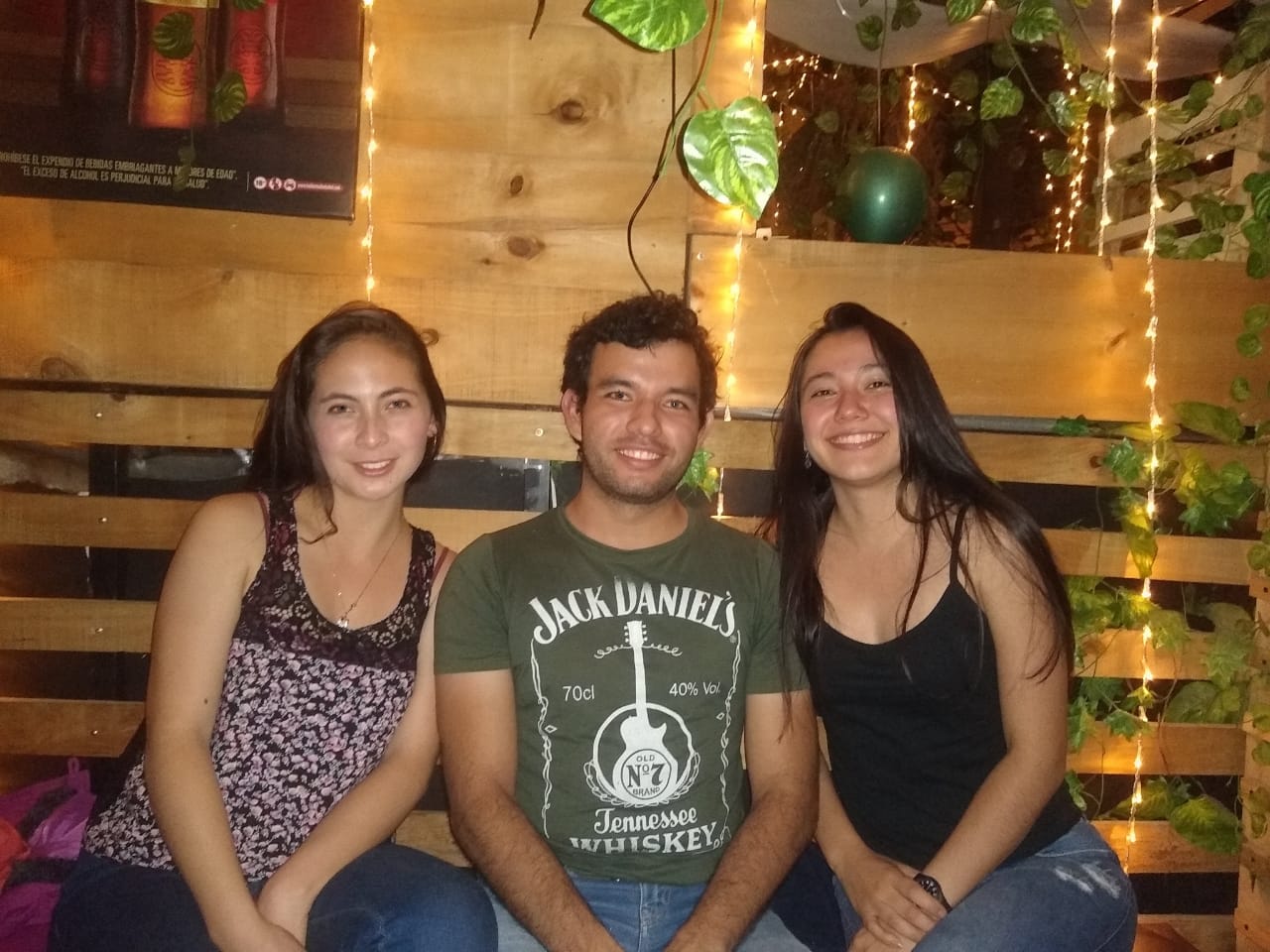
Download Paper
Paper Id : IJRASET54610
Publish Date : 2023-07-05
ISSN : 2321-9653
Publisher Name : IJRASET
DOI Link : Click Here
 Submit Paper Online
Submit Paper Online

